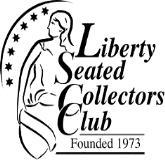

E-Gobrecht
Stepping back in time to a bygone era of the Liberty Seated coin design period, both far and wide, and a little before & after...



(Continued from Cover page)
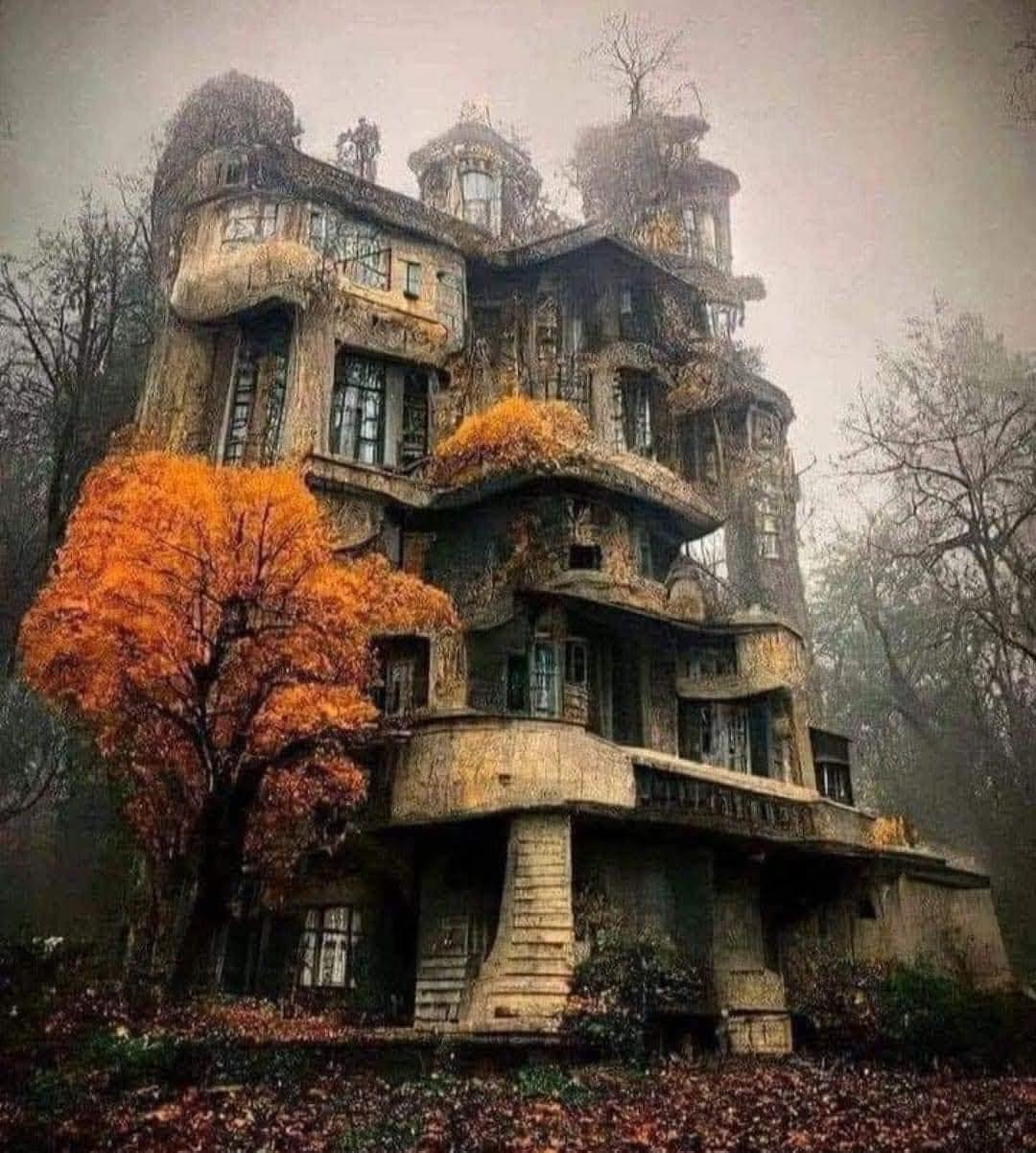
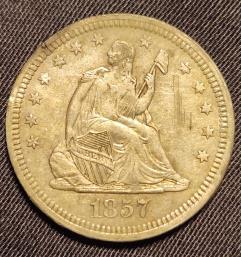
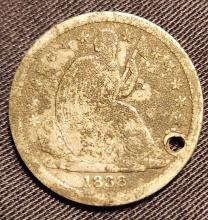
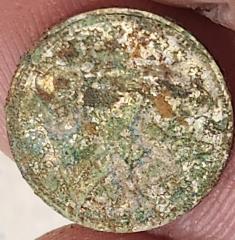

Still a creepy time of the year… Liberty Seated coins metal detected by Troy Moxley of MD. An 1857 Quarter, an 1838 Dime and an 1858 Half Dime (both before and after cleanup). The pictured location might be a fantasy while the actual location of the finds are a secret!


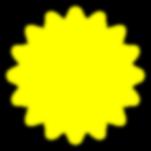
News: LSCC To Gather at the Winter Whitman Baltimore Expo November 6-8 by Ken Otto


: Coin seen at the LSCC Club table display at the South Carolina Numismatic Association Coin Show in October. A picture is worth a thousand words and certainly the PCGS description too in this case!
Coin provided courtesy of Dan Perkins.
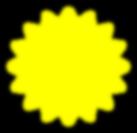
E-Gobrecht’s 250th Issue
The E-Gobrechtis an award winning informal electronic publication of the Liberty Seated Collectors Club (LSCC). The LSCC is a non-profit organization dedicated to the attributions of the Liberty Seated U.S. Coin series. The LSCC provides the information contained in this “electronic” e-mail newsletter from various sources “free of charge” as a general service to the membership and other subscribers with a numismatic interest. You do not have to be a LSCC member to benefit from this newsletter; subscription to the E-Gobrecht is available on a complimentary basis to anyone. All disclaimers are in effect as the completeness and/or accuracy of the information contained herein cannot be completely verified. Contact information for LSCC and this publication can be found on the last page.


President’sMessage
Welcome to our November issue!
Fall is in the air and there is more indoor time to pursue our hobbies. As always, big thanks are due to our editor Paul Kluth, who has indicated his intention to retire in the spring. Congrats to Paul for a substantial tenure in this position!
Please contact me (leonard_augsburger@hotmail.com) should you have any interest in joining the E-Gobrecht editorial team. …Len Augsburger
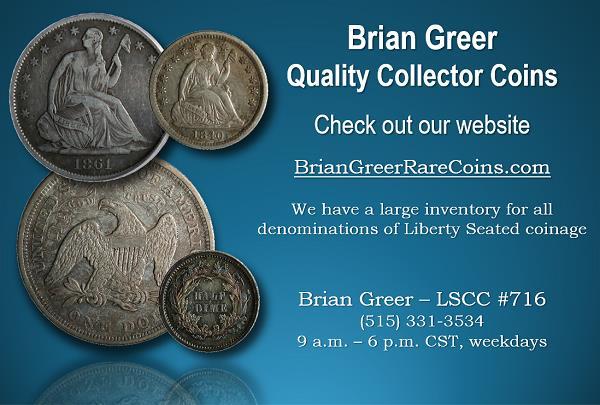

Editor’s‘ViewFromtheRim
What’s Next, 250?… PK
Almost in line with the America’s 250th Anniversary Celebration coming up, is this issue of E-Gobrecht. It has reached the historic milestone of being the 250th issue!
As with history, times do change. The time has come for me to retire as Editor of the E-Gobrecht. Not that I really want to, but in subtle ways, my body is telling me that time has come.
So come April (if not sooner), I hope to turn over the reins to a new individual or team, and retire my keyboard.
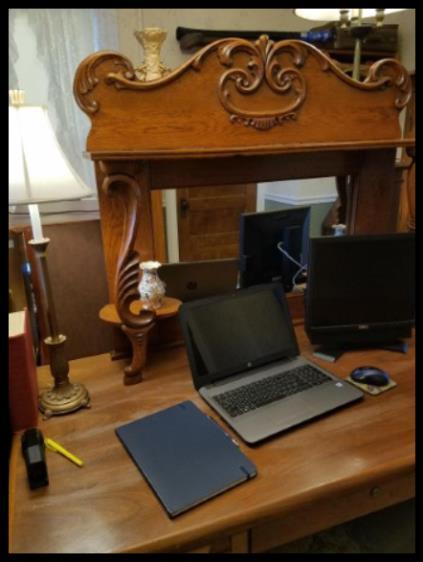
With that said, the Club is currently looking for a replacement, so if you think you might be interested in becoming the next Editor or part of a publishing team, please indicate your interest by emailing E-Gobrecht or President Len Augsburger whose email address is on the back page of this publication or in the Announcement on page 6. We would be happy to answer any questions you might have.
I guess it might be said that “this is a somewhat prestigious role” in the LSCC. Bill Bugert held the position for 15 years. I am not the ironman he was! I will have only served a little over 6 years. But you do get to know a lot of fine folks in numismatics and as I’ve publicly said before, “the 1500 +/- subscribers of E-Gobrecht reads like a “Who’s Who” in hobby.
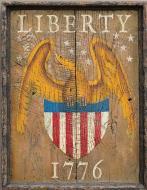


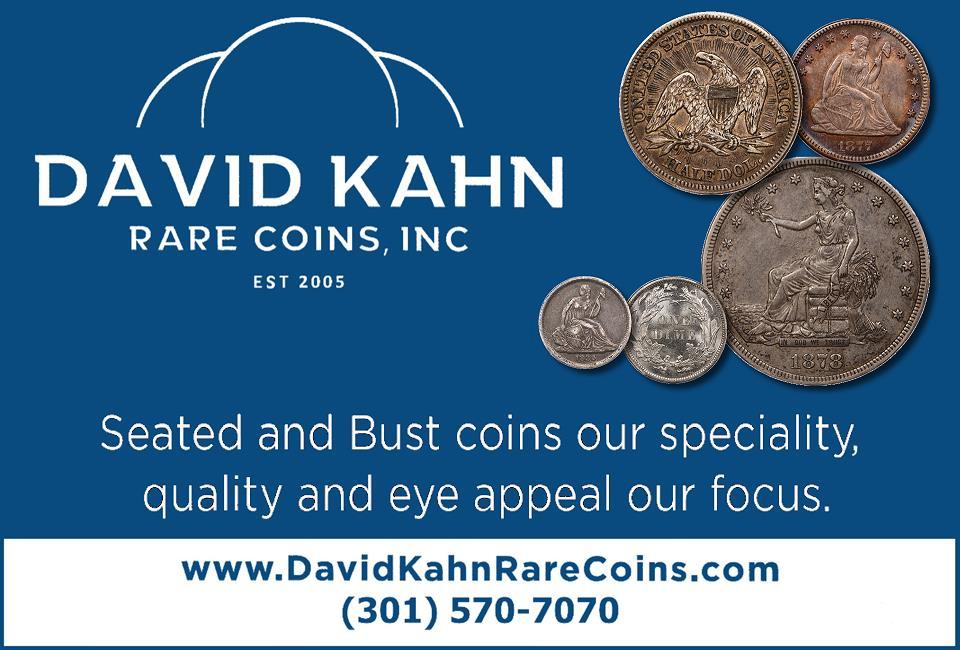
ANNOUNCEMENT
LSCC Club Officers have announced their search for a replacement Editor or publishing team for E-Gobrecht due to the retirement of Paul Kluth. If interested, please contact Len Augsburger at: (leonard_augsburger@hotmail.com)

BCCS Club Meetings, Club Table and Educational Programs are held at most of the LSCC coin show events, and their table is usually next to the LSCC Table for your convenience.

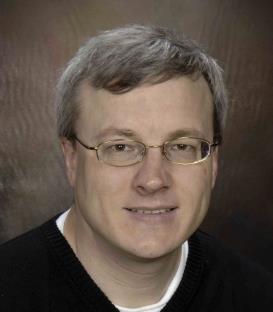
The Curious Collector
by Len Augsburger, LSCC #1271
Fun With 1853/4 Arrows & Rays Quarters
This month we take a look at an overrated variety, the 1853/4 Arrows & Rays quarter (Briggs 1-A). Quarters of the year 1853 are legend, with a mintage over 15 million pieces, and the varieties for this year are seemingly just as numerous. In truth, Briggs reports 119 obverse and 120 reverse dies, and observes that one could spend a lifetime studying the various combinations. I can only agree. The issue is replete with all the problems you would expect from a high-mintage, 19th century coin – die cracks, cuds, rotated dies, and, in this case, mispunched digits.
The Heritage archive notes 157 auction appearances, as compared to a total of 1,524 sales for other 1853 Arrows & Rays pieces. The ratio at PCGS isn’t terribly far different, with 178 reported examples of the overdate, vs. 2,668 grading “events” for the normal date. One can expect to see multiple examples of the overdate at just about any coin show.
Unless you wish to collect die states of the Briggs 1-A, and to be sure there are such collectors among us, I would recommend searching for early die state examples that more strongly exhibit the
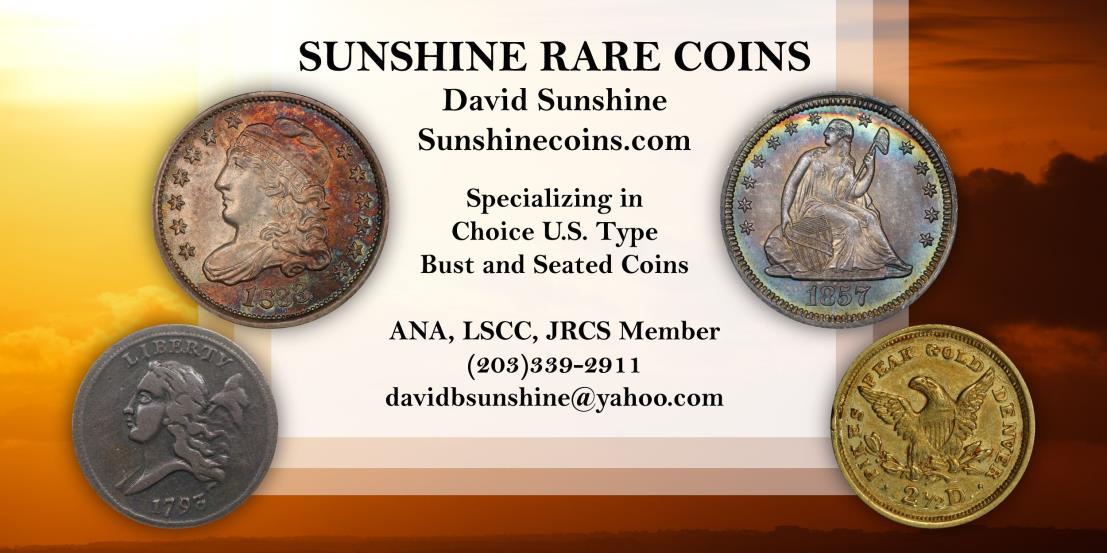

(Continued from previous page)
8
E-Gobrecht #250 –
November 2025
overdate. Here are a couple images courtesy of the Heritage auction archive. The first image below clearly illustrates more “crud” inside the 3, while the arrow remnants are easily more visible. These details are fainter on the second coin shown.

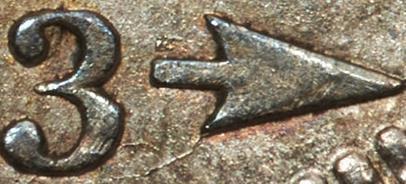
Interestingly, the die cracks are distinctly different on these two examples. Is it possible that more than one obverse die exhibits the overdate? An examination of about twenty examples was not sufficient to definitively answer this question. We will not ever decode the entire production of 1853 Arrows & Rays quarters, but this seems like a question that our collective effort might resolve one way or another. So, here is a bit of homework!

Regional News
by Ken Otto, Regional Team Director, LSCC #2674
LSCC To Gather at the Winter Whitman Baltimore Expo Nov. 6-8
ThemonthofOctoberwasaverybusymonthfortheLSCCRegionalteam. Wesetup at4differentcoinshowsacrossthenationandwouldhavesetupatafifthshowduringthe monthexceptfortheimpactofCovidononeofourteammembers. TheWhitmanBaltimore ExpofollowsearlyinNovemberandwelookforwardasalwaystogatheratthismajorcoin show. TheWhitmanBaltimoreExpoisthelastmajorcoinshowin2025untilWinterFUN earlynextyear.
Firstisfollow-uptorecentcoinshowstheLSCChasparticipatedin:
First of Four: TheLSCCRegionalteamparticipatedintheNorthCarolinaNumismatic Association(NCNA)CoinShowheldOctober3-5attheCabarrusArena&EventsCenter, 4751Hwy49North,Concord,NC28205. JohnLundsten,KenOtto, DennisFortierandothers hostedtheClubtable. Overall,theshowwasareasonablygoodregionalshowandseveral LSCCmembersvisitedtheClubtable.TwoLSCCmembersrenewedtheirmemberships duringtheevent.
Second of Four: TheLSCCteamparticipatedintheDenverCoinExpowhichwasheld October8-11attheNationalWesternComplex,4655HumboltStreet,Denver,CO80216. KeithPooleandKenOttohostedtheClubtable.
Thiswasthesecondyearthatwehad aClubtableattheDenverCoinExpo. Theshowwaswell-attended,andwe metwithmanyexistingLSCCmembers andanumberofprospectivemembers. Threenewmembersweresignedupat theshowandseveralothercoin collectorsindicatedthattheyplanned tojointheLSCCon-line. KeithPooleis showntalkingtoanattendeeinthe imagetotheright:


Regional News cont.
Third of Four: TheLSCCteamparticipatedintheNewHampshireCoin&Currency ExpowhichwasheldOctober24-25attheDoubletreebyHiltonManchesterDowntown, 700ElmStreet,Manchester,NH03101. JoeCasazzaandJohnFrosthostedtheClubtable. JohnFrost’sreportfollows:
October24th and25th broughtustotheNewHampshireCoinExpoinManchester. NortheastDirectorJoeCasazzaandEducationDirectorJohnFrostrepresentedtheLSCCand BCCSattheshow. AFridayeducationalprogramon Liberty Seated and Barber Coinage of the New Orleans Mint waswellreceivedandwasbackedupbyanextensiveexhibitofNew OrleanscoinsattheClubtable.TrafficwassteadywithonenewmemberjoiningtheLSCC. Inaddition,numerousmembersofbothclubsstoppedbytolookattheexhibitandtalk. TheshowhasanexcellentYNprogramsponsoredbyNENA(NewEnglandNumismatic Association),andnumerousYNsstoppedbythetabletolearnaboutO-mintcoins.We alwayslookforwardtothistwice-yearlyshow!
Fourth of Four: TheLSCCRegionalteamparticipatedintheSouthCarolina NumismaticAssociationShowheldOctober23-25attheGreenvilleConventionCenter, 1ExpositionDrive,Greenville,SC29607. JohnLundstenandDanPerkinshostedtheClub table. Someofthecoinsdisplayedareshowninthephotosthatfollowonthenextfewpages:
Almost Five of Five (...lol): TheLSCCRegionalteamhadplannedtoparticipateinthe PennsylvaniaAssociationof Numismatists(PAN)FallCoinShowwhichwasheldOctober1618attheMonroevilleConventionCenter,209MallBlvd,Monroeville,PA15146. Unfortunately,oneoftheRegionalteammemberscontractedCovidandcouldnotattend theshow. Asaresult,wehadtocancelourparticipationinthisyear’sevent,butweplanto returnnextyeartotheFallPANcoinshow.
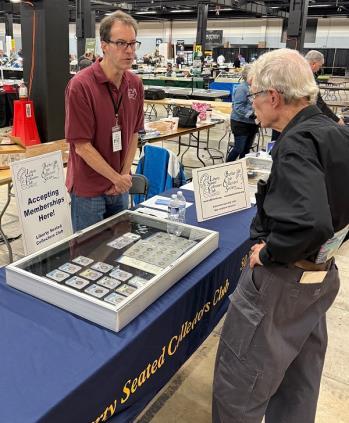
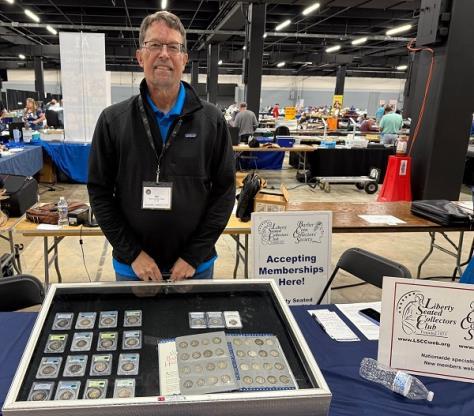
(Continued on next page)
John Lundsten and Dan Perkins hosting the Club tables in SC

Regional News cont.
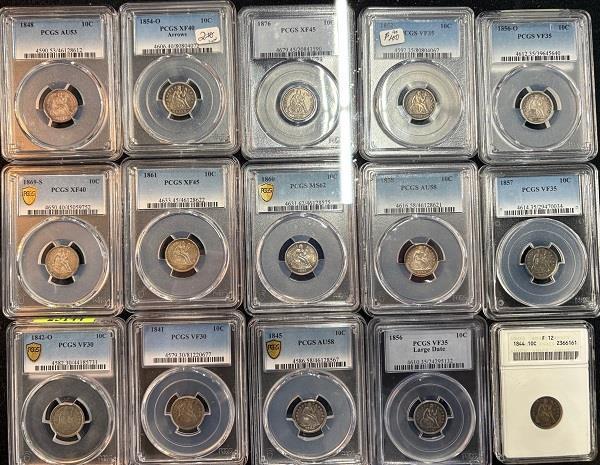
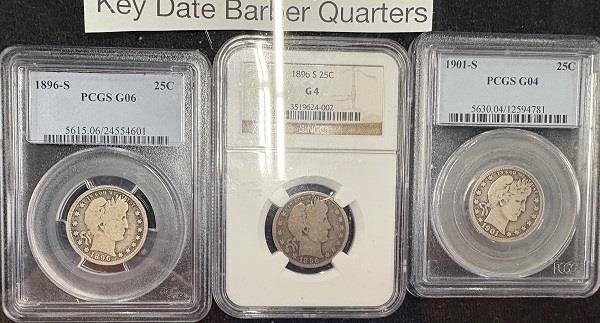
Liberty Seated Dimes and Key Date Barber Quarters displayed in SC
(Continued on next page)

Regional News cont.
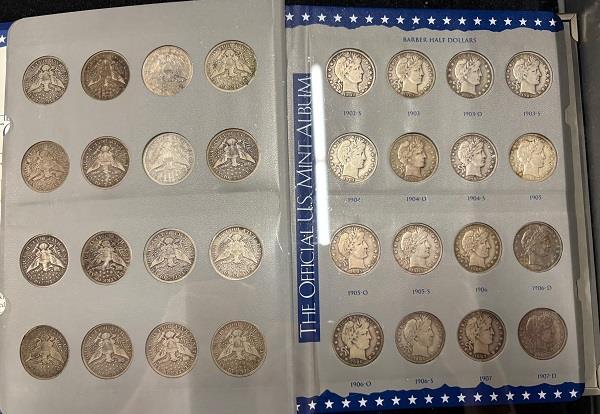

(Continued on next page)
Barber Half Dollars and “fast-growing” supporting local Sumter Coin Club in SC

Regional News cont.
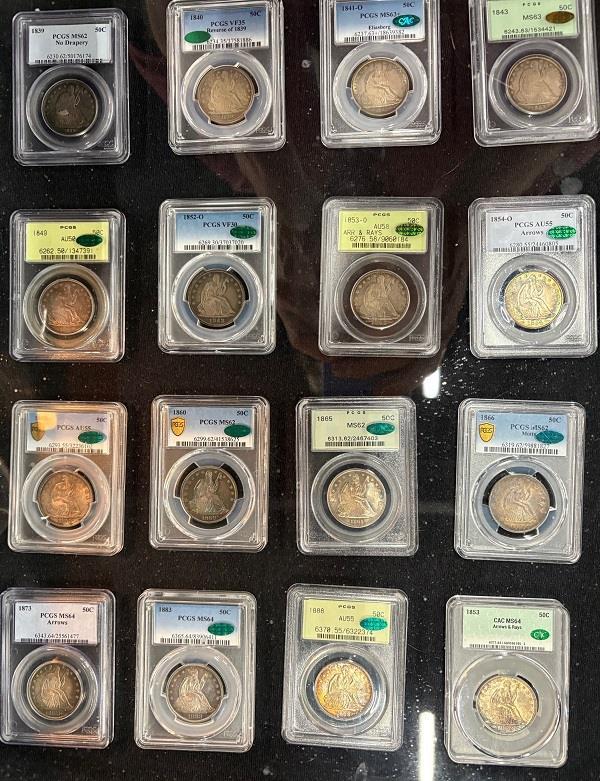
(Continued
Liberty Seated Halves displayed in SC

Regional News cont.
Upcoming Coin Show Events for the LSCC (Some events include the BCCS too)
TheRegionalLSCCteamwillparticipateintheWhitmanWinterBaltimoreExpo onNovember6-8attheBaltimoreConventionCenter(HallsA,B&C),OneWestPratt Street,Baltimore,MD21201. Thisisamajorfallnationalshowinthemid-Atlantic. WewillhaveaClubmeetingat9AMonFriday,November7thwithaninterestingeducationalprogram. TheClubtablewillbehostedbyJohnFrost,DennisFortier,Joe Casazza,KenOttoandothers.
Of special note: In Baltimore, Joel Meredith will be speaking on shipwreck Seated coinage for the educational program, and there will be several door prizes of shipwreck coins during the meeting. Many thanks to Joel for sponsoring this generous giveaway.
TheRegionalLSCCteamwillalsoparticipateintheWinterFUNCoinShowto beheldJanuary8-11attheOrangeCountyConventionCenter,North/SouthBldg., Orlando,FL32869. Thisisanother majornationalshowthatkicksoffthecoinmarket inthenewyear. TheLSCCwillhaveamajorpresenceatthiseventandhaveaClub meetingduringtheshow. TheClubtablewillbehostedbyJohnFrost,DennisFortier, JoeCasazza,CarlFeldman,KenOttoandothers.
TheRegionalLSCCteamwillbeonhandtoofortheHoustonMoneyShowbeing heldJanuary16-17attheLoneStarConventionCenter,9055AirportRoad,Conroe,TX 77303. Thisisawell-attendedRegionalcoinshowandtheLSCCnormallyhasa presencethere. TheClubtablewillbehostedbyJohnFrostandKenOtto. JohnFrost isscheduledtomakeaneducationalpresentationattheHoustonMoneyShow.

A Counterstamped Pocket Piece
Case 2
by Bill Groom
Most counterstamped coins served some commercial purpose. Many circulated to promote word-of-mouth advertising, akin to “little billboards.” Others served as tool checks, passes or tickets of sorts, receipts for items left with a merchant, employee ID's and a wide variety of business operations. These stamped coins were accordingly struck in small and large numbers; most often, by virtue of a single, prepared stamp.
During the Civil War, die sinkers and engravers utilized individual letter and number punches to create identification disks for soldiers to carry. Many years later, during WWI, comparable military ID's were deemed “dog tags.” Civil War era ID's, like the one pictured below, often show letter misalignment. Some makers took great care in punching ID's, but others lacked alignment tools and/or finesse.

Russell C. Jackson of Leon, NY was a private in the Cattaraugus Regiment of the N.Y State Volunteers.
Note the central misalignment of letters. The well-placed peripheral letters suggest that the maker likely had a tool to better assist with that application.

While the 1850's were “boom years” for counterstamped coins, the love token fad of engraving coins boomed after the Civil War. Surviving host coins today show us that the two practices, punching and engraving, often intersected. Many counterstamps qualify as love tokens...
Successful businessmen of yesteryear routinely carried pocket watches. If they were a mason or member of another fraternal order, they might also carry a personalized coin to serve as a badge and/or conversation-starter. The coins were often holed and attached to watch fobs; sometimes, gifted by a loved one. Most were engraved but many were counterstamped. The 1866 Liberty Seated half dollar, on the next page, is an example. The stamping reads: C.G. SHEPARD. / BUFFALO, N.Y.
(Continued on

(Continued
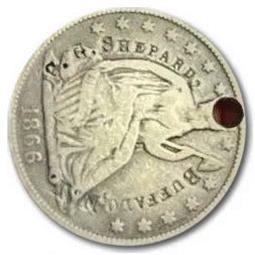
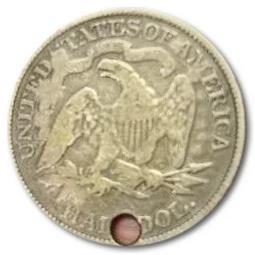

Note the artful placement of the name and town, carefully aligned in love token fashion.
This counterstamp, was unknown to Brunk and Rulau. Brunk listed an S. SHEPARD & CO. / BUFFALO, N.Y. counterstamp on an 1861-O half dollar, # S-377; this, likely Sidney, possibly a relative to C.G. Shepard. A search of early Buffalo directories reveals but one C.G. Shepard.
Charles G. (Gurley?) Shepard, 1850-1928, was but 16 years old in 1866 when C.G. Shepard & Company was founded. Walter J. Shepard (father to Charles?} was a senior partner in this iron hardware business. (Note that 1866 is the date of this counterstamped love token coin.) Might this stamped coin have been gifted to Charles by his father who, in 1866, set young Charles up in business? If so, what a great backstory!
Apparently, the company name was later changed to Shepard Hardware Company. Note that Charles and Walter are cited as the principals, whereas John D. Shepard (perhaps an uncle or grandfather to Charles) is cited as company founder in 1866.
This Mammoth Foundry was situated on a 3.5 acre plot. It's noted that Buffalo's access to the Great Lakes and Erie Canal likely benefited the business to a large extent, shipping-wise.


(Continued
Charles was apparently a gifted inventor and artist. Having become knowledgeable in the iron business, he and one Peter Adams secured patent for at least a dozen mechanical toy banks, during the 1880's. They also marketed trading cards that promoted the banks; today, highly sought after by collectors, as are the banks. Shown below are some of these products…

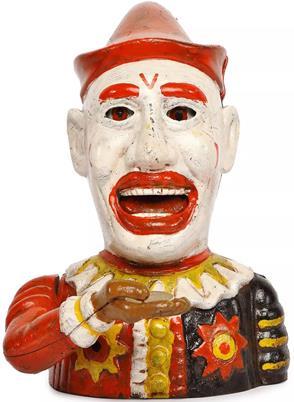
These mechanical toy banks encouraged children to save money and still do, even today!

By 1892, the Shepards' had sold their business to J. & E. Stevens of Cromwell, CT. Since that time, their toy banks have been reproduced by many other companies, foreign and domestic. Original Shepard banks have realized many thousands of dollars at auction, whereas modern copies can now be had for well under a hundred dollars.
Closing thoughts on the counterstamp: As counterstamps go, this C.G. Shepard attribution is highly-probable; this, as opposed to its being proof-positive. In this collector's estimation, the singular directory evidence alone doesn't make for a proof-positive attribution. However, circumstantial evidence pertaining to the 1866 date does tend to elevate the level of proof somewhat. Ideally, was a matching stamp to be found on a mechanical toy bank or other iron product, that evidence would constitute a proof positive attribution.
In closing, the study of counterstamps, attributed or not, can be very engaging. There are many thousands of maverick counterstamps presently begging attribution. This writer encourages others to attempt solving their mystery. Do keep in mind that gathering solid and/or strong circumstantial evidence is key to making the case.
Recommended Reading about the Shepard Banks: “OLD MECHANICAL BANKS of the SHEPARD HARDWARE COMPANY” by Bill Normanhttps://www.mechanicalbanks.org/scrapbook/1980s/ pages/1982_shepard_banks.htm

ACollector’s Exhibit on Liberty Seated Coins (Part II)
by Steve D'Ippolito, LSCC #2294
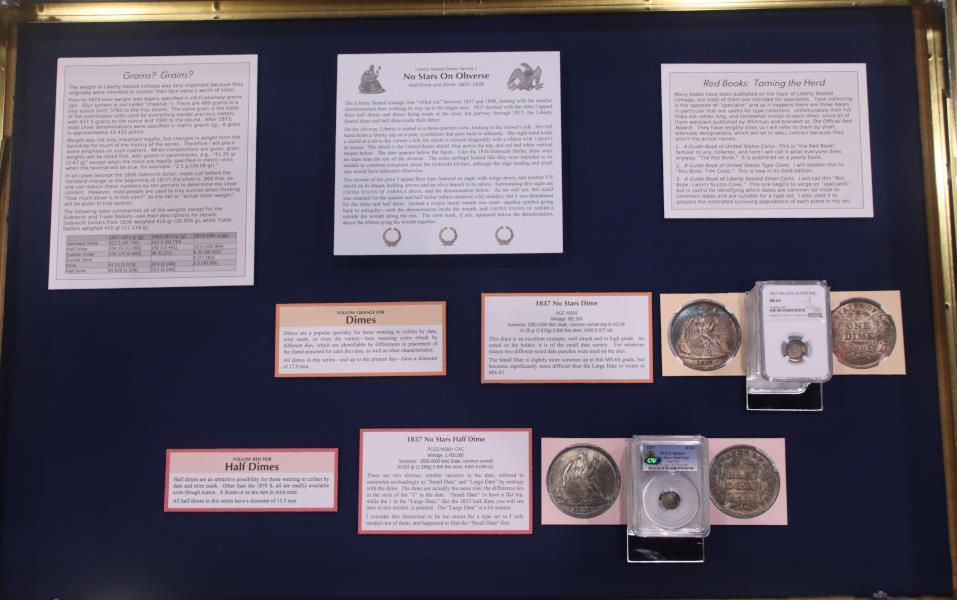
Liberty Seated Series Variety No Stars On Obverse
Half Dime and Dime: 1837–1838
The Liberty Seated coinage was “rolled out” between 1837 and 1840, starting with the smaller denominations then working its way up to the larger ones. 1837 dawned with the older Capped Bust half dimes and dimes being made at the mint, but partway through 1837, the Liberty Seated dime and half dime made their debut.
On the obverse, Liberty is seated in a three-quarters view, looking to the viewer’s left. Her left hand holds a liberty cap on a pole, symbolism that goes back to antiquity. Her right hand holds a shield at a tilt to the viewer’s left; the shield is crossed diagonally with a ribbon with liberty in incuse. The shield is the United States shield, blue across the top, and red and white vertical stripes below. The date appears below the figure. Like the 1836 Gobrecht Dollar, there were no stars near the rim of the obverse. The coins perhaps looked like they were intended to be medals (a common complaint about the Gobrecht Dollar), although the edge reeding and small size would have indicated otherwise.

(Continued from previous page) (Continued on next page)
Grams? Grains?
The weight of Liberty Seated coinage was very important because they originally were intended to contain their face value’s worth of silver.
Prior to 1873 their weight was legally specified in US Customary grains (gr). (Our system is not called “Imperial.”) There are 480 grains to a troy ounce (ozt), 5760 to the troy pound. The same grain is the basis of the avoirdupois units used for everything except precious metals, with 437.5 grains to the ounce and 7000 to the pound. After 1873, most silver denominations were specified in metric grams (g). A gram is approximately 15.432 grains.
Weight was not only important legally, but changes in weight form the backdrop for much of the history of the series. Therefore I will place some emphasis on such matters. When compositions are given, grain weights will be listed first, with grams in parentheses, e.g., “41.25 gr (2.67 g)” except when the coins are legally specified in metric units, when the reverse will be true, for example, “2.5 g (38.58 gr).”
In all cases (except the 1836 Gobrecht dollar, made just before the standard change at the beginning of 1837) the silver is .900 fine, so one can reduce these numbers by ten percent to determine the silver content. However, most people are used to troy ounces when thinking “how much silver is in this coin?” so the net or “actual silver weight” will be given in troy ounces.
The following table summarizes all of the weights except for the Gobrecht and Trade Dollars - see their descriptions for details. Gobrecht Dollars from 1836 weighed 416 gr (26.956 g), while Trade Dollars weighed 420 gr (27.216 g).
Red Books: Taming the Herd
Many books have been published on the topic of Liberty Seated coinage, but most of them are intended for specialists. Type collecting is the opposite of “specialist” and as it happens, there are three books in particular that are useful for type collectors. Unfortunately, their full titles are rather long, and somewhat similar to each other, since all of them were/are published by Whitman and branded as The Official Red Book®. They have lengthy titles so I will refer to them by short, alternate designations, which will be in small capitals because they aren’t the actual names.
1. A Guide Book of United States Coins. This is “the Red Book” familiar to any collector, and here I will call it what everyone does anyway: “THE RED BOOK”. It is published on a yearly basis.
2. A Guide Book of United States Type Coins. I will shorten this to “RED BOOK: TYPE COINS”. This is now in its third edition.
3. A Guide Book of Liberty Seated Silver Coins. I will call this “Red Book: Liberty Seated Coins.” This one begins

(Continued
to verge on “specialist,” but is useful for identifying which dates are common (or close to common) and dates suitable for a type set. I also used it to prepare the estimated surviving populations of each piece in my set.
follow orange for
Dimes
Dimes are a popular specialty for those wanting to collect by date, mint mark, or even die variety - here meaning coins struck by different dies, which are identifiable by differences in placement of the (hand-punched for each die) date, as well as other characteristics.
All dimes in this series - and up to the present day - have a diameter of 17.9 mm.

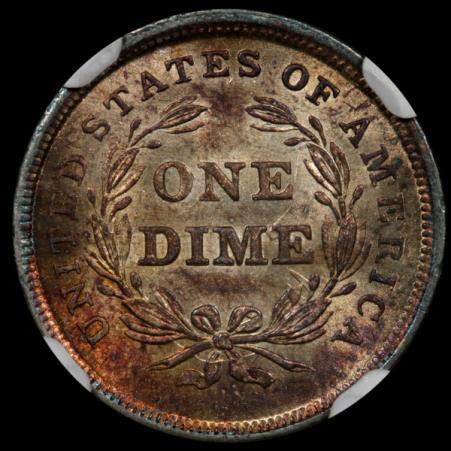
1837 No Stars Dime
NGC MS64
Mintage: 682,500
Survivors: 1050-1500 Mint State, common overall especially in VG-VF 41.25 gr (2.672g) 0.900 fine silver, ASW 0.077 ozt.
This dime is an excellent example, well struck and in high grade. As noted on the holder, it is of the small date variety. For whatever reason, two different-sized date punches were used on the dies.
The Small Date is slightly more common up to this MS-64 grade, but becomes significantly more difficult than the Large Date to locate in MS-65.
(Continued

(Continued from previous page)
follow Red for
Half Dimes
Half dimes are an attractive possibility for those wanting to collect by date and mint mark. Other than the 1870 S, all are readily available even though scarce. A dozen or so are rare in mint state.
All half dimes in this series have a diameter of 15.5 mm
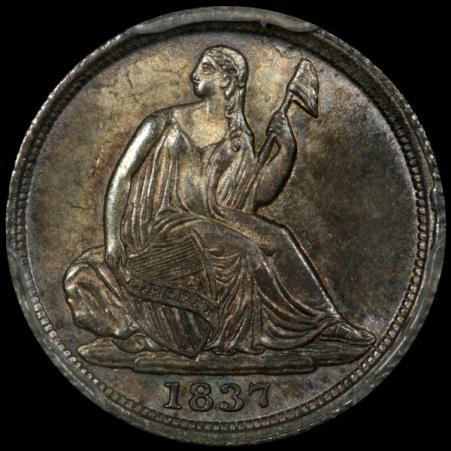
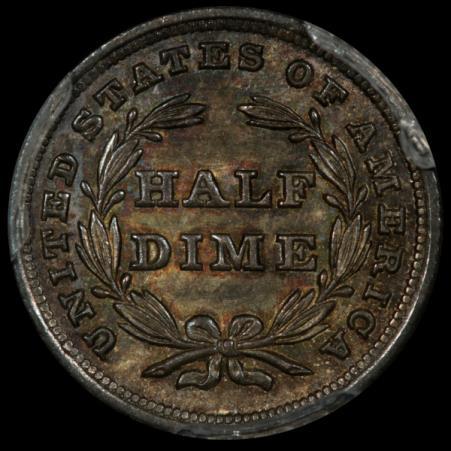
1837 No Stars Half Dime
PCGS MS64+ CAC
Mintage: 1,450,000
Survivors: 2800-4000 Mint State, common overall 20.625 gr (1.336g) 0.900 fine silver, ASW 0.039 ozt.
There are two distinct, notable varieties in the date, referred to somewhat misleadingly as “Small Date” and “Large Date” by analogy with the dime. The dates are actually the same size; the difference lies in the style of the “1” in the date. “Small Date” 1s have a flat top, while the 1 in the “Large Date,” like the 1853 half dime you will see later in this exhibit, is pointed. The “Large Date” is a bit scarcer.
I consider this distinction to be too minor for a type set so I only needed one of them, and happened to find the “Small Date” first.
(Continued

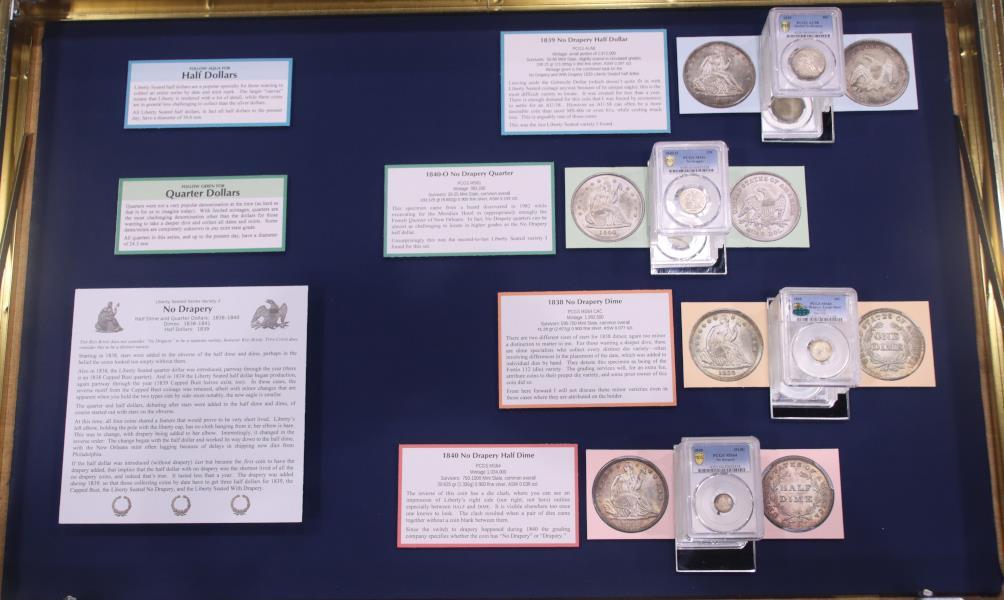
Liberty Seated Series Variety 2 No Drapery
Half Dime and Quarter Dollars: 1838–1840
Dimes: 1838-1841
Half Dollars: 1839
THE RED BOOK does not consider “No Drapery” to be a separate variety, however RED BOOK: TYPE COINS does consider this to be a distinct variety.
Starting in 1838, stars were added to the obverse of the half dime and dime, perhaps in the belief the coins looked too empty without them.
Also in 1838, the Liberty Seated quarter dollar was introduced, partway through the year (there is an 1838 Capped Bust quarter). And in 1839, the Liberty Seated half dollar began production, again partway through the year (1839 Capped Bust halves exist, too). In these cases, the reverse motif from the Capped Bust coinage was retained, albeit with minor changes that are apparent when you hold the two types side by side - most notably, the new eagle is smaller.
The quarter and half dollars, debuting after stars were added to the half dime and dime, of course started out with stars on the obverse.
At this time, all four coins shared a feature that would prove to be very short lived. Liberty’s left elbow, holding the pole with the liberty cap, has no cloth hanging from it; her elbow is bare. This was to change, with drapery being added to her elbow. Interestingly, it changed

(Continued
in the reverse order: The change began with the half dollar and worked its way down to the half dime, with the New Orleans mint often lagging because of delays in shipping new dies from Philadelphia.
If the half dollar was introduced (without drapery) last but became the first coin to have the drapery added, that implies that the half dollar with no drapery was the shortest lived of all the no drapery coins, and indeed that’s true. It lasted less than a year. The drapery was added during 1839, so that those collecting coins by date have to get three half dollars for 1839, the Capped Bust, the Liberty Seated No Drapery, and the Liberty Seated With Drapery.
follow Aqua for
Half Dollars
Liberty Seated half dollars are a popular specialty for those wanting to collect an entire series by date and mint mark. The larger “canvas” means that Liberty is rendered with a lot of detail, while these coins in general are less challenging to collect than the silver dollars.
All Liberty Seated half dollars, in fact all half dollars to the present day, have a diameter of 30.6 mm.
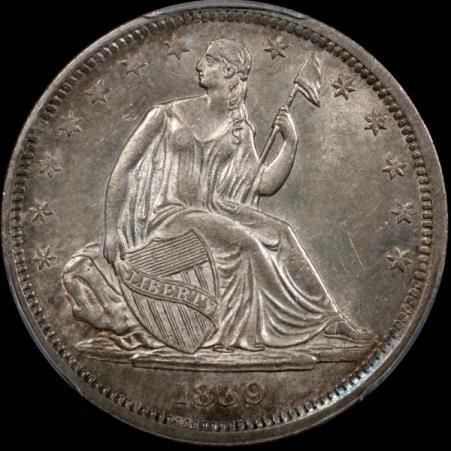
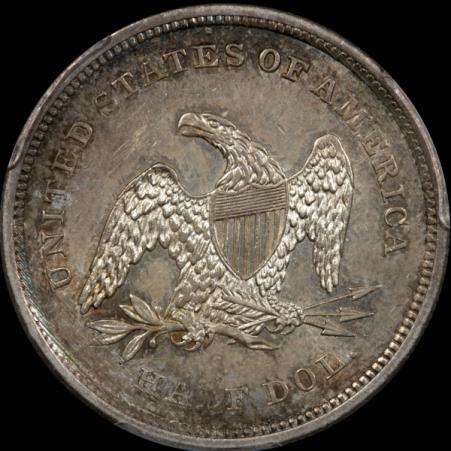
1839 No Drapery Half Dollar
PCGS AU58
Mintage: small portion of 1,972,000
Survivors: 50-65 Mint State, slightly scarce in circulated grades. 206.25 gr (13.365g) 0.900 fine silver, ASW 0.387 ozt.
Mintage given is the combined total for the No Drapery and With Drapery 1839 Liberty Seated half dollar.
(Continued on next page)

(Continued from previous page)
Case 2
Leaving aside the Gobrecht Dollar (which doesn’t quite fit in with Liberty Seated coinage anyway because of its unique eagle), this is the most difficult variety to locate. It was created for less than a year. There is enough demand for this coin that I was forced by economics to settle for an AU-58. However an AU-58 can often be a more desirable coin than most MS-60s or even 61s, while costing much less. This is arguably one of those cases.
This was the last Liberty Seated variety I found.
follow Green for
Quarters
Quarters were not a very popular denomination at the time (as hard as that is for us to imagine today). With limited mintages, quarters are the most challenging denomination other than the dollars for those wanting to take a deeper dive and collect all dates and mints. Some dates/mints are completely unknown in any mint state grade.
All quarters in this series, and up to the present day, have a diameter of 24.3 mm

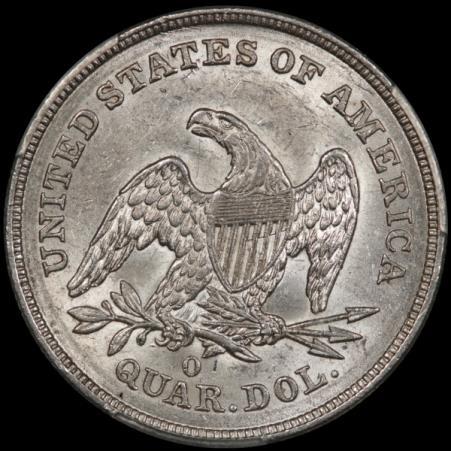
-O No Drapery Quarter

(Continued
Case 2
This specimen came from a hoard discovered in 1982 while excavating for the Meridien Hotel in (appropriately enough) the French Quarter of New Orleans. In fact, No Drapery quarters can be almost as challenging to locate in higher grades as the No Drapery half dollar.
Unsurprisingly this was the second-to-last Liberty Seated variety I found for this set.
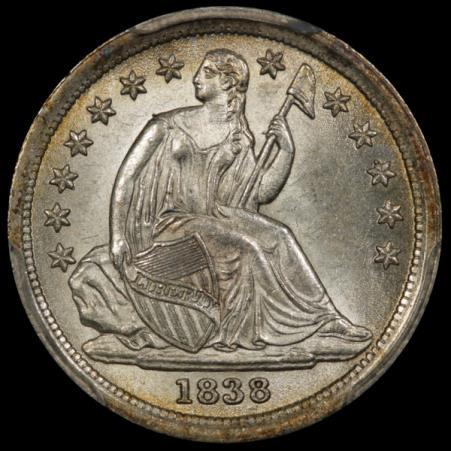

1838 No Drapery Dime
PCGS MS64 CAC
Mintage: 1,992,500
Survivors: 590-750 Mint State, common overall 41.25 gr (2.672g) 0.900 fine silver, ASW 0.077 ozt.
There are two different sizes of stars for 1838 dimes; again too minor a distinction to matter to me. For those wanting a deeper dive, there are dime specialists who collect every distinct die variety - often involving differences in the placement of the date, which was added to individual dies by hand. They denote this specimen as being of the Fortin 112 (die) variety. The grading services will, for an extra fee, attribute coins to their proper die variety, and some prior owner of this coin did so.
From here forward, I will not discuss these minor varieties even in those cases where they are attributed on the holder.
(Continued on next page)

(Continued
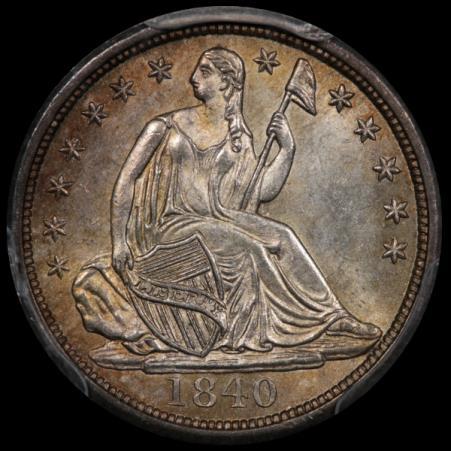
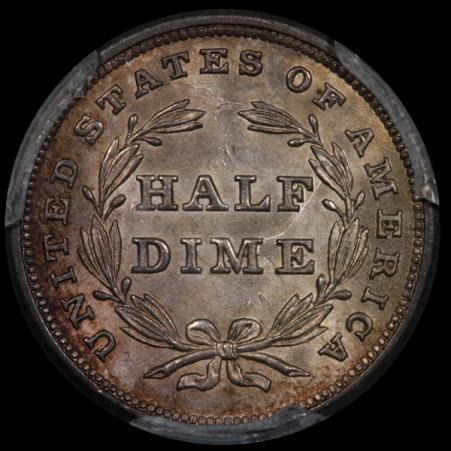
1840 No Drapery Half Dime
PCGS MS64
Mintage 1,034,000
Survivors: 750-1000 Mint State, common overall 20.625 gr (1.336g) 0.900 fine silver, ASW 0.039 ozt.
The reverse of this coin has a die clash, where you can see an impression of Liberty’s right side (our right, not hers) outline especially between half and dime. It is visible elsewhere too once one knows where to look. The clash resulted when a pair of dies came together without a coin blank between them.
Since the switch to drapery happened during 1840, the grading company specifies whether the coin has “No Drapery” or “Drapery.”
To be continued in Part III and beyond...


#250 - November 2025
Monthly E-Gobrecht Newsletter Advertising Rates

(Prices are per issue. All ads should include some Liberty Seated coins and/or related material.)
Full Page $100
Half Page $ 50
Quarter Page $ 30
Inquires & Special Rates: Contact Advertising Manager Jeff Pritchard at jjpsr2@gmail.com
Deadline: 25th of the month prior to month of issue
For Advertising in The Gobrecht Journal, see contact above.
E-Gobrecht Deadline for Subscriber Submissions 30th of the month prior to month of issue
Send Submissions to: Paul Kluth, Editor e-gobrecht@msn.com
Next Deadline for Submissions to The Gobrecht Journal: Fall 2025 - September 1st
Send Inquiries & Submissions to: lscc@lsccweb.org LSCC Website & Member Application is at: https://lsccweb.org/

LSCC 2025-2026 Regional Events Calendar ***
November 6-8 Whitman Baltimore Winter Expo, Baltimore Convention Center (Halls A, B & C), Baltimore, MD - Club meeting on Friday at 9 am with an educational presentation described below, a Club breakfast likely or a dinner (check at Club table for specifics), and LSCC/BCCS combined Club tables hosted by many members of both clubs. The BCCS will also have a Club meeting and educational program that same Friday in the afternoon.
In Baltimore, Joel Meredith will be speaking on shipwreck Seated coinage for the educational program, and there will be several door prizes of shipwreck coins during the meeting.
January 8-11, 2026 Winter FUN Show, Orange County Convention Center, Noth/South Building, Orlando, FL - Club meeting and educational program, Club dinner, and LSCC/BCCS combined Club tables hosted by many LSCC/BCCS members.
January 16-17, 2026 Houston Money Show, Lone Star Convention Center, Conroe, TX - Club meeting and educational program by John Frost and Club table.
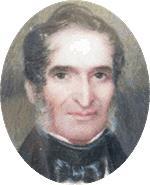
*** More event details and addresses of show locations are in Ken Otto’s Regional Report found on page 14. Also see either or both the LSCC/BCCS websites for information and any late changes.
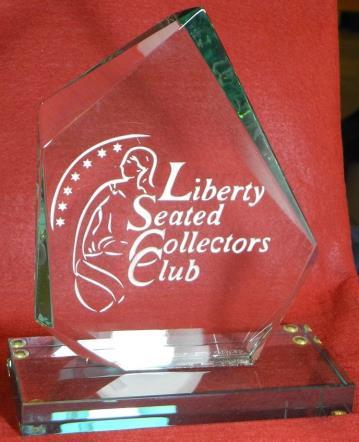


(END) WilliamBarber
ChristianGobrecht
National Officers
President Leonard Augsburger leonard_augsburger@hotmail.com
Vice President Craig Eberhart craig@eberhart.us
Secretary Jeff Pritchard PO Box 10771, Bainbridge, WA 98110 jjpsr2@gmail.com
Treasurer John Lundsten john.lundsten@yahoo.com
National Positions
The Gobrecht Journal Publication Greg Johnson (Editor/Publisher) lscc@lsccweb.org
E-Gobrecht Monthly Newsletter Paul Kluth (Editor/Publisher) e-gobrecht@msn.com
New Membership Chairman Joe Casazza jsazza236@gmail.com
Education Director John Frost john.frost@doubledimes.com
Advertising Director Jeff Pritchard jjpsr2@gmail.com
Team Leader - Regional Directors Ken Otto kenotto53@gmail.com
Director - Southern Region John Lundsten (email above)
Director - Northeast Region Joe Casazza (email above)
Director - Western Region Open Position
Director - Central Region Dennis Fortier ricajun@msn.com
Club Website: www.lsccweb.org
Liberty Seated Collectors Club Mission
To encourage, promote, and dispense numismatic knowledge of Liberty Seated coins; to cultivate fraternal relations among its members and all those interested in the science of numismatics.
LSCC Membership Information: Dues are bargain priced at $30 per year and include 3 packed issues of The GobrechtJournal, an award winning numismatic publication printed in glossy, full color. To join the Liberty Seated Collectors Club, for GobrechtJournal mailing address changes, or for other membership questions, please correspond with Craig Eberhart, LSCC Secretary listed on this page.
Articles, comments, or advertisements for publication in TheGobrechtJournal magazine may be addressed to Greg Johnson, Gobrecht Journal Publication Editor.
Submissions, correspondence, information and comments for this digital publication (E-Gobrecht)are actively encouraged from its subscribers and may be sent to Paul Kluth, E-Gobrecht Publication Editor.
To be added as a “free” subscriber to E-Gobrechtor removed from the mailing list or to change your email address, please send an email message indicating your preference in the subject line to: e-gobrecht@msn.com
Wanted: Submissionsforthisnewsletter!
Please consider submitting something for print. It need not be elaborate; it can be something as simple as a short note on a favorite coin, variety, neat find, happening at a coin show or local club, Liberty Seated coinage at auction, etc. If you are interested in it; rest assured, others will be too!
Sharing information is a goal of this newsletter and you need not be an experienced writer to submit material of interest to others. “This is your monthly digital publication. It is what you make of it!”
Please be sure to quote the E-Gobrecht and the LSCC as its contents are not copyrighted. Use it contents freely.
